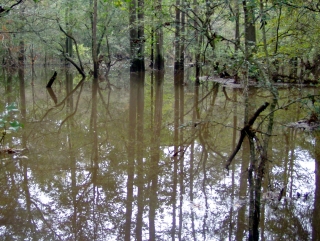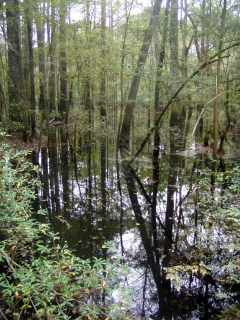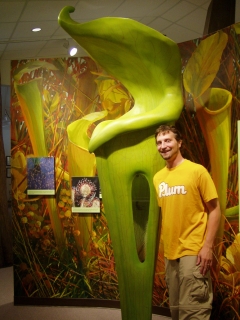NPS Website; Local Website
 WHAT IS IT?
WHAT IS IT?Biological crossroads where the southeastern swamplands, eastern deciduous forest. Midwest prairie and pine savannas meet. The Park consists of nine distinct land units, a few of which are connected by two river corridor units. Roads and towns weave through the parklands; it is hard to believe that there are 97,000 acres of parkland among the outer reaches of suburbia.
BEAUTY (7/10)
In some of Big Thicket N PRES, the result of the clashing eco-zones is a dark stew of mysterious swampland. We were enchanted on are walk along the boardwalks of the Kirby Nature Trail in the Turkey Creek Unit of the Park. Rain fell above us, caught on the floral canopy above. The dark black waters of the surrounding swamps dutifully reflected the large oaks and beech trees. Despite the overwhelming visual evidence, Big Thicket does not feel like the swamps of the south. There are few palmettos, less green and more browns. It almost feels like a wet, overrun Pennsylvania forest.
UNESCO named Big Thicket a World Biosphere Zone in 1981 because of its unique floral and fauna diversity and also because its existence remains severely threatened by oil exploration. The Park contains four of North America’s five species of carnivorous plants and is a birding hot spot. We were lucky to see the elusive Bachman Sparrow. We came at the wrong time to see the beautiful Painted Bunting, a bird Michael has wanted to see since he was an elementary school student.
HISTORICAL INTEREST (4/10)
The discovery and drilling of oil is tantamount to Big Thicket and the surrounding area. Oil was first discovered at the famed Spindletop site, located a few miles from the park, on lands that were probably once similar to the site’s environs. Presently, Big Thicket has become the centerpiece to a Sierra Club lawsuit that accuses the Bush Administration of surreptitiously changing the drilling rights in the National Parks.
 CROWDS (6/10)
CROWDS (6/10)We enjoyed a wonderful solitary walk through the marshes. We might have enjoyed hikes through other Units had the specter of gun-wielding deer hunters not frightened us away. A team of SCA, a conservation Peace Corps, youth lingered in the Visitor Center while waiting for Park Service canoes to do scientific testing. We were jealous. It was refreshing to see the SCA kids doing environmental research instead of their usual NPS perch as fee collectors. Research work rather than customer service should be the emphasis of their internships.
EASE OF USE/ACCESS (3/5)
The Big Thicket N PRES Visitor Center is located about 30 miles north of Beaumont, Texas and Interstate 10. Beaumont is 80 miles from the sprawling metropolis of Houston. Parts of Big Thicket are as close as 4 miles from Beaumont. Other Units are as far away as 60 miles.
This may sound confusing. Big Thicket is not one park. Its 11 spindly units resemble gerrymandered congressional districts; they all hug creeks, rivers and bayous. If you have a canoe, the Park is your oyster. Silent sojourns through the dark marshes sound spectacular to us. Without a canoe, your choices become somewhat limited. The hikers unit, Turkey Creek, provides a wonderful boardwalked path through the Big Thicket. Hiking is possible in only three other units. Be sure to bring mosquito repellent.
Since the park is a National Preserve, hunting is allowed in the other units. We arrived during deer season and did not dare travel outside of the safe Turkey Creek haven. Oil drilling occurs in the Big Sandy Creek area and has become a flashpoint. The companies have breeched their contract by taking too much oil. The hunters are angry and want their peaceful park back.
CONCESSIONS/BOOKSTORE (3/5)
Standard fare at the Big Thicket bookstore: books identifying local plants and birds, a children’s section and some regional information on Texas. Nothing exceptional, except for the stuffed toy armadillos.
COSTS (4/5)
Park entry is free. Hunting, backcountry camping and fishing are all free with a permit.
Four nearby outfitters provide canoe rentals.
RANGER/GUIDE TO TOURIST RATIO (2/5)
How come we always seem to arrive at sites on the Rangers’ day off? Big Thicket was no exception. Nonetheless, we received gobs of attention from a cheery, knowledgeable volunteer. We are sure the Ranger in the back room, who had come to do computer work on her day off, would have verified the volunteer’s able answers.
 TOURS/CLASSES (7/10)
TOURS/CLASSES (7/10)The Big Thicket N PRES VC does a terrific job at explaining the complex ecological crossroads that is the Park. Numerous fun, interactive displays highlight each of the biological regions. The exhibits are delightful and educational for kids and adults alike. Michael especially enjoyed sticking his hand in the massive human-sized Pitcher Plant replica. For a second, he felt like he was in a Star Trek episode and was in grave danger.
The Visitor Center also provides tons of mimeographed handouts whose topics include birding hot spots, carnivorous plants, hiking trails and even an auto tour. A number of videos are available for viewing. The only downside to the Park’s educational opportunities is the lack of Ranger talks. We had seen pictures of a canoe-led Ranger talk and got excited. These tours no longer take place.
FUN (7/10)
We are really enjoying our time spent at the National Preserves. Big Thicket is no exception. The ability to hunt on the land is one of the things that sets Preserves apart from Parks. The ability to utilize private contributions in creative ways seems to be another. Trails through Big Thicket are primarily over boardwalks. Almost every boardwalk has been dutifully maintained by a local Boy Scout group or business. A wooden plank below one’s feet commemorates each effort.
We contemplated canoeing, but there were thunderstorms in the forecast. The boardwalks got us plenty close to the dark, swampy waters. No feral pig or javalina sightings for us, which is just as well. They look pretty mean.
Did we mention our spotting of the Bachman Sparrow? It doesn’t take much to get us novice birders excited.
WOULD WE RECOMMEND? (7/10)
Communities around Big Thicket N PRES know what a treasure they have in their back yards. Hunters rely on Big Thicket for bountiful game; the Park relies on the hunters to control the nutria and feral pig populations and to canvas the sprawling units and report on the wildlife they encounter. “We couldn’t do it without them,” remarked the volunteer. A hunter reported the first brown bear in the Preserve last year. Hikers and canoers both enjoy hunt-free areas set aside for their use. Two hikers spotted a panther (local speak for a mountain lion) on a hike earlier this year. The Preserve’s doubting wildlife expert went out for a closer look and was not disappointed.
There is a wonderfully symbiotic relationship between the Preserve, hunters, hikers and canoers. There is room for everyone who respects the land and helps to preserve it. Let’s hope they can all unite to combat the latest drilling intrusions.
TOTAL 50/80
www.usa-c2c.com
© 2004-06